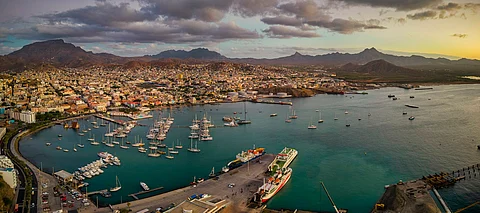

The World Bank’s new report estimates that Cabo Verde, a small archipelago located off the coast of West Africa, will need to invest $842 million over 2024-2030, or $140 million per year, to address its climate and development challenges.
The report titled Country Climate and Development Report (CCDR) was launched on January 15, 2025.
As a small island developing state (SIDS) located in the Atlantic Ocean, Cabo Verde is highly vulnerable to extreme climate events including extreme heat, floods, droughts, tropical storms, landslides, volcanic eruptions, coastal erosion and sea level rise.
Structural factors such as rapid rural-urban migration and land degradation further aggravate the country’s vulnerability to natural hazards.
These vulnerabilities are further compounded by economic challenges, such as heavy reliance on tourism, imported fuel and goods that account for 80 per cent of domestic food consumption, as well as high public debt. Climate change threatens to exacerbate these issues, with projections showing potential gross domestic product (GDP) losses of up to 3.6 per cent by 2050 without effective adaptation measures.
The report analyses how Cabo Verde can build climate resilience and stimulate low carbon development (energy, transport, waste and ICT), while identifying key enablers like macroeconomics, fiscal policy and microeconomics, finance, institutional and legal framework and capacity, and the private sector.
The report outlines several immediate priorities to enhance climate resilience and secure long-term economic and social well-being.
According to the report, an integrated water and land management approach will be crucial to strengthening food security. The country should continue to prioritise expanding and improving the efficiency of its irrigation systems, diversifying the agricultural portfolio toward fruit trees and horticulture, and introducing more drought resistant crops to enhance food security.
Cabo Verde’s blue natural capital can be considered foundational to national development. Tourism will remain central to the economy, as it accounts for a quarter of its GDP and 45 per cent of formal sector jobs. Cross-sector coordination and integrated planning are essential for the sustainable use of Cabo Verde’s blue capital.
Five of the country’s 10 islands could see half of their road networks impacted by a severe flood event. Rising sea levels threaten to submerge vital coastal transport infrastructure, which would impact vital sectors and access to critical facilities like hospitals and schools.
The report estimates that the annual average losses for Cabo Verde from various climate and disaster risks, including floods, earthquakes, volcanic eruptions, and droughts amount to nearly 1 per cent of GDP, equivalent to $18.2 million.
Cabo Verde should prioritise infrastructure investments and better integrate climate considerations into infrastructure planning, says the report.
Even though Cabo Verde accounts for less than 0.002 percent of total global emissions, the country’s Nationally Determined Contribution (NDC) still aims to decarbonise the energy sector, which accounts for 73 per cent of national emissions, and achieve a 100 per cent share of renewable energy penetration by 2040.
The country should boost public investments for grid upgrades and deploy storage solutions while attracting private capital through financial reforms and risk mitigation facilities.
According to the report, climate action would boost growth but requires private financing.
The report estimates that ambitious climate action would require investment totaling $842 million over 2024-2030, or $140 million per year, which represents 6 per cent of cumulative GDP over the same period.
These climate investments would generate significant economic benefits in the form of higher agricultural productivity, higher tourism arrivals, reduced fuel imports, and lower air pollution.